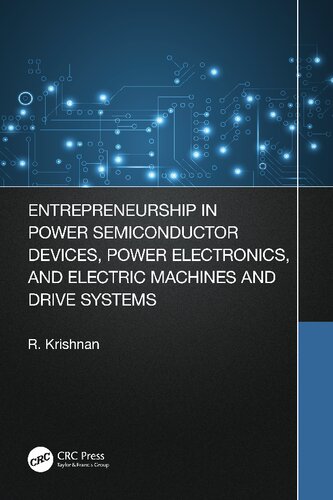

Most ebook files are in PDF format, so you can easily read them using various software such as Foxit Reader or directly on the Google Chrome browser.
Some ebook files are released by publishers in other formats such as .awz, .mobi, .epub, .fb2, etc. You may need to install specific software to read these formats on mobile/PC, such as Calibre.
Please read the tutorial at this link: https://ebookbell.com/faq
We offer FREE conversion to the popular formats you request; however, this may take some time. Therefore, right after payment, please email us, and we will try to provide the service as quickly as possible.
For some exceptional file formats or broken links (if any), please refrain from opening any disputes. Instead, email us first, and we will try to assist within a maximum of 6 hours.
EbookBell Team

4.3
58 reviewsEntrepreneurship in Power Semiconductor Devices, Power Electronics, and Electric Machines and Drive Systems introduces the basics of entrepreneurship and a methodology for the study of entrepreneurship in electrical engineering and other engineering fields. Entrepreneurship is considered here in three fields of electrical engineering, viz. power semiconductor devices, power electronics and electric machines and drive systems, and their current practice. It prepares the reader by providing a review of the subject matter in the three fields, their current status in research and development with analysis aspect as needed, thus allowing readers to gain self-sufficiency while reading the book. Each field’s emerging applications, current market and future market forecasts are introduced to understand the basis and need for emerging startups.
Practical learning is introduced in: (i) power semiconductor devices entrepreneurship through the prism of 20 startups in detail, (ii) power electronics entrepreneurship through 28 startup companies arranged under various application fields and (iii) electric machines and drive systems entrepreneurship through 15 startups in electromagnetic and 1 in electrostatic machines and drive systems.
The book: (i) demystifies entrepreneurship in a practical way to equip engineers and students with entrepreneurship as an option for their professional growth, pursuit and success; (ii) provides engineering managers and corporate-level executives a detailed view of entrepreneurship activities in the considered three fields that may potentially impact their businesses, (iii) provides entrepreneurship education in an electrical engineering environment and with direct connection and correlation to their fields of study and (iv) endows a methodology that can be effectively employed not only in the three illustrated fields of electrical engineering but in other fields as well.
This book is for electrical engineering students and professionals. For use in undergraduate and graduate courses in electrical engineering, the book contains discussion questions, exercise problems, team and class projects, all from a practical point of view, to train students and assist professionals for future entrepreneurship endeavors.